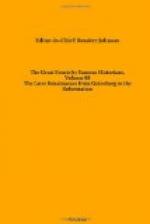The Lady Margaret,[1] whom the King’s friends called Juno, because she was to him as Juno was to Aeneas, stirring both heaven and hell to do him mischief, for a foundation of her particular practices against him, did continually, by all means possible, nourish, maintain, and divulge the flying opinion that Richard, Duke of York, second son to Edward IV, was not murdered in the Tower, as was given out, but saved alive. For that those who were employed in that barbarous act, having destroyed the elder brother, were stricken with remorse and compassion toward the younger, and set him privily at liberty to seek his fortune.
There was a townsman of Tournai, that had borne office in that town, whose name was John Osbeck, a convert Jew, married to Catherine de Faro, whose business drew him to live for a time with his wife at London, in King Edward’s days. During which time he had a son[2] by her, and being known in the court, the King, either out of a religious nobleness because he was a convert, or upon some private acquaintance, did him the honor to be godfather to his child, and named him Peter. But afterward, proving a dainty and effeminate youth, he was commonly called by the diminutive of his name, Peterkin or Perkin. For as for the name of Warbeck, it was given him when they did but guess at it, before examinations had been taken. But yet he had been so much talked of by that name, as it stuck by him after his true name of Osbeck was known.
While he was a young child, his parents returned with him to Tournai. There he was placed in the house of a kinsman of his called John Stenbeck, at Antwerp, and so roved up and down between Antwerp and Tournai, and other towns of Flanders, for a good time, living much in English company and having the English tongue perfect. In which time, being grown a comely youth, he was brought by some of the espials of the Lady Margaret into her presence. Who, viewing him well, and seeing that he had a face and personage that would bear a noble fortune, and finding him otherwise of a fine spirit and winning behavior, thought she had now found a curious piece of marble to carve out an image of a Duke of York. She kept him by her a great while, but with extreme secrecy.
The while she instructed him by many cabinet conferences. First, in princely behavior and gesture, teaching him how he should keep state, and yet with a modest sense of his misfortunes. Then she informed him of all the circumstances and particulars that concerned the person of Richard, Duke of York, which he was to act, describing unto him the personages, lineaments, and features of the King and Queen, his pretended parents; and of his brother and sisters, and divers others, that were nearest him in his childhood; together with all passages, some secret, some common, that were fit for a child’s memory, until the death of King Edward. Then she added the particulars of the time from the King’s death, until he and his brother were committed to the Tower, as well during the time he was abroad as while he was in sanctuary. As for the times while he was in the Tower, and the manner of his brother’s death, and his own escape, she knew they were things that a very few could control. And therefore she taught him only to tell a smooth and likely tale of those matters, warning him not to vary from it.




